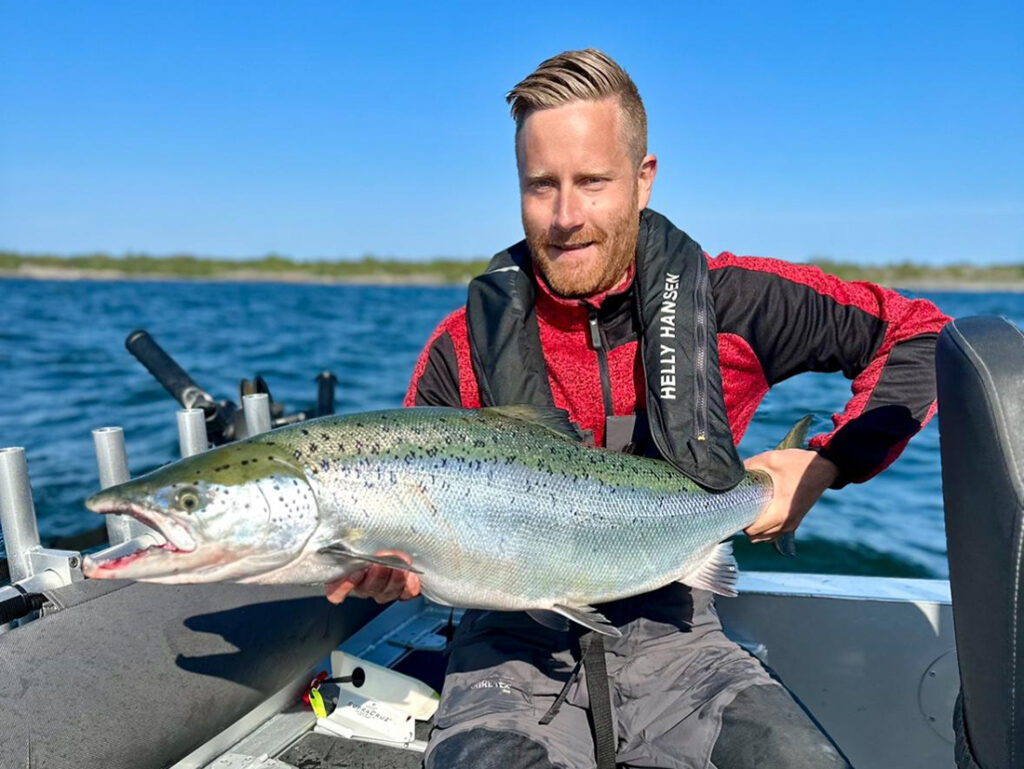A successful day trolling for Baltic salmon can yield one or two keepers along with numerous fish that need to be released.
Photo courtesy of Capt. Björn Persson
“Straight ahead is Poland, and to the left is Estonia,” Capt. Björn Persson remarked while steering the tranquil waters toward the Baltic Sea. We were headed out to catch Baltic salmon, a species within the Salmonidae family, identical to Atlantic salmon. The Atlantic population in the Baltic is renowned for its substantial size, with world records documented in Sweden, Denmark, Poland, and Russia. Our target was the larger specimens: those weighing 30 pounds or more.
Moments ago, we departed from the port of Trosa, situated roughly an hour southwest of Stockholm. The journey through the Stockholm archipelago (known as Skärgårdens in Swedish) was serene and scenic, with remnants of World War II cannons visible on several small islands. This region boasts the world’s second-largest archipelago, featuring around 30,000 islands. That day, we spotted as many sailboats as motorboats on the water.
We quickly reached the deeper waters of the Baltic Sea within 20 minutes. Persson engaged the trolling motor, and one by one, he released line on his Abu Garcia Alphamar LC level-wind reels, outfitted with large artificial spoons.
Uncertain about the precise depth where the Atlantic salmon might be located, we deployed eight lines at depths of approximately 130, 165, and 195 feet. An additional four lines were set at greater depths, utilizing a pair of downriggers at the back of the 21-foot center console. To keep the lines from tangling and to stagger them at varied depths, the captain employed fluorescent planer boards. With a total of twelve lines in the water, our spirits were high.
Before long, a rod bent sharply, and the captain exclaimed something in Swedish that likely translated to “fish on.” I seized the rod, enjoying the battle, but quickly reeled the fish close. The captain evaluated it and immediately released it back into the water. Our mission was to catch large salmon, particularly those over two feet, not what we had caught. It was not the fish we sought, and there was no time for photos.
“You should have been here last week,” he recalled as the day went on. Ultimately, our time was limited, and the captain grilled hamburgers and hot dogs on the shore of a small island. He shared tales of enormous Baltic salmon he had caught in these waters, claiming the size of the fish was only restricted by the reach of his arms.
### When to Go
The waters surrounding Sweden comprise the second-largest archipelago globally, encompassing around 30,000 islands.
Photo by Doug DaSilva
The Baltic salmon season in Sweden runs from June to August. It’s an excellent opportunity to catch northern pike and numerous European perch across Sweden’s many lakes. If you’re planning a family outing or want to explore, consider visiting during the midsummer festival, which celebrates the summer solstice. This event marks the day the Earth’s poles tilt maximally toward the sun, resulting in the year’s longest period of daylight. Midsummer is also one of Sweden’s most significant holidays, during which locals don traditional attire and engage in singing and drinking festivities.
### Where to Go and How to Get There
Airports in New York usually have several direct flight options to Stockholm, Sweden’s capital. If your goal is to see an impeccably preserved 196-foot, 400-year-old Viking warship, the Vasa Museum in Stockholm is a must-visit. From there, you can drive or take a train to Trosa, a charming fishing and coastal town about an hour southeast of Stockholm. The area features local markets offering fresh seafood and produce from vendors, along with various restaurants.
### What to Expect
A summer visit to Sweden resembles a trip to the Great Lakes or Canada; hence, it’s wise to bring layers in case a hot day turns chilly. A productive day of trolling for Baltic salmon may yield one or two keepers. Consider mixing your trip with a day of catching numerous perch and sizable pike at nearby lakes. There’s no need for concern, as most locals speak English and are eager to guide tourists in the right direction.

